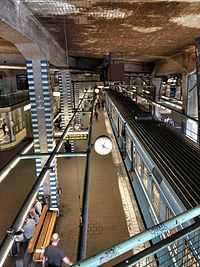Saltsjöbanan


Saltsjöbanan is an electrified suburban rail system between Stockholm and Saltsjöbaden in Nacka, Sweden. It is 18.5 kilometres (11.5 mi) in length and has eighteen stations in use. An average of 19,600 journeys are made on an ordinary workday. The line is mainly single-track, and is isolated from Sweden's national railway network, although both are built to compatible standard gauge (1,435 mm/4 ft 8 1⁄2 in).
History

K.A. Wallenberg largely initiated and financed the project. The railway's initial purpose was to offer a quick way for stressed-out Stockholm residents to get to planned beaches and recreational facilities around Saltsjöbaden. The construction of the railway went faster than expected, but turned out to be very expensive, mostly owing to the problems building the last stretch into the city, which involved a lot of tedious work with explosives to even out the ground and to build two long tunnels, one of which was the country's longest at the time of the construction.
Saltsjöbanan was inaugurated on 1 July 1893 and was operated with steam locomotives until 1910 after which the lines were gradually electrified (circa 1 kV DC). The construction of the branch that runs from Igelboda to Solsidan (also called Vårgärdsbanan) was fully contracted to a Danish company, Brøchner-Larsen & Krogh. The branch opened in 1913. [1]
Initially the railway was operated by Järnvägs AB Stockholm-Saltsjön, and carried a great deal of profitable freight traffic. This diminished with time, and by the 1960s it was no longer breaking even, and a complete closure was considered. However, the Stockholm County Council took over the line in 1969, and today it is owned by Storstockholms Lokaltrafik (SL).
To this day, the route remains mostly unchanged since the early 1900s, but has seen slight alterations at its outer ends. In the 1940s, the western end was extended by about 400 metres (440 yards), moving its Stockholm terminus from Stadsgården to the more centrally located Slussen interchange (the diversion point can be seen in the image at left). Conversely, the easternmost end, which once ran all the way to the Saltsjöbaden shore, for convenient transfer to archipelago ferries, now stops about 200 metres (220 yards) inland. A railway branch also used to go from slightly west of Östervik to a gravel pit in Snörom, a distance of about 3 km. It was however only used for industrial purposes. The branch was decommissioned as early as 1902 and all that remains today is a minor road with the same stretch.
Vehicles and technology
As of 2009, the trains running on Saltsjöbanan are EMU sets of two or three cars. They are made by ASEA, models C10 (with motor) and C11 (motorless). The cars are slight modifications to an older model of Stockholm Metro train. Maximum allowed speed is 70 km/h (43 mph).
The railroad does not feature ATC, in contrast to most other rail traffic in Sweden. This makes collisions and overruns such as the January 2013 incident much more likely to happen. Currently, operators must strictly obey traffic lights indicating whether a stretch is in use or not to prevent collisions, and trains do not automatically brake at the end of the line. Experts have suggested that ATC should be implemented on the railroad. [2]
Accidents and incidents
In the early morning hours of 15 January 2013, a passenger train started to move without authorization, with only a cleaner on board. At maximum speed, it violently overran a set of buffer stops and crashed into a block of flats in Saltsjöbaden.[3][4] The cleaner was first suspected of having stolen the train, but was later cleared of blame, as the train was then considered to have started moving due to some train malfunction and violation of safety procedures.[5]
Lines

The main line runs from Slussen to Saltsjöbaden, while a branch line connects the intermediate station Igelboda to Solsidan. At Slussen it meets the Stockholm Metro’s Red and Green lines.
Sometimes in the late evening, the Solsidan line may continue from its Igelboda terminus and go further to Slussen.
Line 25- Slussen- Nacka - Igelboda - Saltsjöbaden
Line 26- Solsidan- Tattby - Igelboda (In late evenings - trains continue to Slussen)
References
- ↑ http://www.jarnvag.net/index.php/banguide/banor-svealand/slussen-saltsjobaden?tmpl=component&print=1&page=
- ↑ http://sverigesradio.se/sida/artikel.aspx?programid=103&artikel=5411267
- ↑ "Cleaning lady steals train and crashes into house". The Local. Retrieved January 15, 2013.
- ↑ "Stockholm train crashed into apartments 'by cleaner'". BBC News Online. Retrieved January 15, 2013.
- ↑ "Cleaner in train crash cleared of suspicion". The Local. Retrieved January 18, 2013.